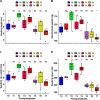Seed priming with potassium nitrate alleviates the high temperature stress by modulating growth and antioxidant potential in carrot seeds and seedlings
- PMID: 38926658
- PMCID: PMC11201870
- DOI: 10.1186/s12870-024-05292-1
Seed priming with potassium nitrate alleviates the high temperature stress by modulating growth and antioxidant potential in carrot seeds and seedlings
Erratum in
-
Correction: Seed priming with potassium nitrate alleviates the high temperature stress by modulating growth and antioxidant potential in carrot seeds and seedlings.BMC Plant Biol. 2024 Jul 18;24(1):679. doi: 10.1186/s12870-024-05414-9. BMC Plant Biol. 2024. PMID: 39020300 Free PMC article. No abstract available.
Abstract
Early season carrot (Daucus carota) production is being practiced in Punjab, Pakistan to meet the market demand but high temperature hampers the seed germination and seedling establishment which cause marked yield reduction. Seed priming with potassium nitrate breaks the seed dormancy and improves the seed germination and seedling growth potential but effects vary among the species and ecological conditions. The mechanism of KNO3 priming in high temperature stress tolerance is poorly understood yet. Thus, present study aimed to evaluate high temperature stress tolerance potential of carrot seeds primed with potassium nitrate and impacts on growth, physiological, and antioxidant defense systems. Carrot seeds of a local cultivar (T-29) were primed with various concentration of KNO3 (T0: unprimed (negative control), T1: hydroprimed (positive control), T2: 50 mM, T3:100mM, T4: 150 mM, T5: 200 mM, T6: 250 mM and T7: 300 mM) for 12 h each in darkness at 20 ± 2℃. Seed priming with 50 mM of KNO3 significantly enhanced the seed germination (36%), seedling growth (28%) with maximum seedling vigor (55%) and also exhibited 16.75% more carrot root biomass under high temperature stress as compared to respective control. Moreover, enzymatic activities including peroxidase, catalase, superoxidase dismutase, total phenolic contents, total antioxidants contents and physiological responses of plants were also improved in response to seed priming under high temperature stress. By increasing the level of KNO3, seed germination, growth and root biomass were reduced. These findings suggest that seed priming with 50 mM of KNO3 can be an effective strategy to improve germination, growth and yield of carrot cultivar (T-29) under high temperature stress in early cropping. This study also proposes that KNO3 may induces the stress memory by heritable modulations in chromosomal structure and methylation and acetylation of histones that may upregulate the hormonal and antioxidant activities to enhance the stress tolerance in plants.
Keywords: Carrot growth; Heat stress; Potassium nitrate; Reactive oxygen species; Seed treatments.
© 2024. The Author(s).
Conflict of interest statement
The authors declare no competing interests.
Figures








References
-
- MacLaren C, Mead A, van Balen D, Claessens L, Etana A, de Haan J, et al. Long-term evidence for ecological intensification as a pathway to sustainable agriculture. Nat Sustain. 2022;5(9):770–9. doi: 10.1038/s41893-022-00911-x. - DOI
-
- Krishna H, Hebbar S, Kumar P, Sharma S, Kumar R, Tiwari SK, et al. Navigating challenges and prospects in off-season Vegetable Production. Vegetable Sci. 2024;51:97–105. doi: 10.61180/vegsci.2024.v51.spl.09. - DOI
-
- Nijabat A, Bolton A, Mahmood-ur-Rehman AI, Shah R, Hussain NH, Naveed A, Ali P. Simon. Cell Membrane Stability and Relative Cell Injury in Response to heat stress during early and late seedling stages of Diverse Carrot (Daucus carota L.) Germplasm. HortScience. 2020;55(9):1446–52. doi: 10.21273/HORTSCI15058-20. - DOI
-
- Bose B, Pal H. Impact of Climate Change on Vegetable Production. In: Hasanuzzaman M, editor. Climate-resilient agriculture. 1. Cham: Springer; 2023.
MeSH terms
Substances
LinkOut - more resources
Full Text Sources
Medical

